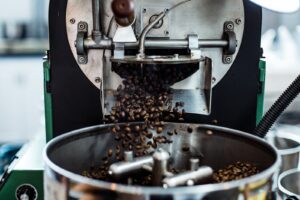Coffee Roasting: Unveiling the Secrets of Flavor Transformation
Coffee roasting is a crucial step in the coffee production process. By subjecting green coffee beans to heat, toxins are removed, flavors are enhanced. The aromatic qualities of coffee are concentrated. Initially, green coffee beans are hard, odorless, and contain bitter compounds. Roasting is essential to alter the chemical composition and physiology of the beans, resulting in a delightful sensory experience.
The Coffee Roasting Process: Unleashing the Flavors
 Various methods have been developed to roast coffee, all utilizing similar fundamental processes. The journey begins by heating the green coffee beans, causing the endogenous evaporation of water. As the temperature reaches around 160°C, exogenous chemical reactions occur, reaching their peak at approximately 220°C. With increased pressure, carbon dioxide and water vapor are expelled, leading to a decrease in bean density, expansion in size, and even popping. The duration of the roasting process, typically lasting from nine to fifteen minutes. The time determines the desired roast level. To halt the process, rapid cooling through water or cool air is employed.
Various methods have been developed to roast coffee, all utilizing similar fundamental processes. The journey begins by heating the green coffee beans, causing the endogenous evaporation of water. As the temperature reaches around 160°C, exogenous chemical reactions occur, reaching their peak at approximately 220°C. With increased pressure, carbon dioxide and water vapor are expelled, leading to a decrease in bean density, expansion in size, and even popping. The duration of the roasting process, typically lasting from nine to fifteen minutes. The time determines the desired roast level. To halt the process, rapid cooling through water or cool air is employed.
The Transformations Within: Changes in the Coffee Bean
During roasting, various visible changes occur in the coffee bean. The vibrant green hue gives way to shades of brown or nearly black. The density diminishes by approximately 40%. The volume expands by nearly half of the coffee bean’s original size. Moreover, a significant loss of water content, up to 85%. This contributes to the concentrated flavors and intensified aroma characteristic of roasted coffee.
Commercial Coffee Roasting Methods: Unveiling the Techniques
In commercial settings, coffee beans are typically roasted in horizontal or vertical rotating drums equipped with paddles. These drums expose the beans to hot gases. Which can reach temperatures of nearly 450°C upon entering but cool as they mix with the beans. The duration of roasting, between 9 and 15 minutes, depends on the desired outcome. The gas-to-coffee ratio plays a crucial role, as a higher ratio allows for faster roasting at lower temperatures.
One prevalent method in commercial coffee roasting is Fluidized Bed Roasting. By subjecting coffee beans to bursts of high-velocity gases from beneath, they move uniformly across the fluidized bed. This results in a high-quality final product. Careful adjustment of gas speed in different sections of the machine ensures consistent roasting.
Another technique employed is Fast Roasting, which rapidly roasts coffee beans. Sometimes in as little as one minute (though it may take up to four minutes). This method relies on a high gas-to-coffee ratio, leading to a higher brew strength and increased bean density and volume.
The Art of Roasting: Unleashing the Aromatic Delights
The method used to roast coffee significantly impacts its appearance and taste. Through the art of coffee roasting, a seemingly ordinary, odorless green coffee bean is magically transformed. Creating into a captivating, aromatic, and delectable brew that captivates our senses. Embrace the artistry of coffee roasting and indulge in the wonderful world of flavors that await.